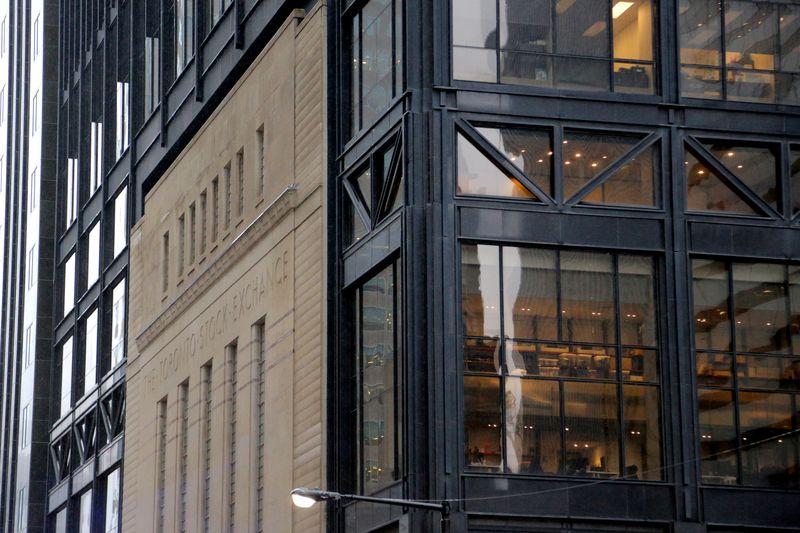One & One Green Technologies stock soars 100% after IPO debut
Investing.com - Canada’s main stock exchange was lower on Friday, after U.S. President Donald Trump unveiled an executive order lifting tariffs on a dozens of countries.
By 12.05 ET, the S&P/TSX 60 index standard futures contract had dropped by 15.24 points, or 0.94%.
Toronto Stock Exchange’s S&P/TSX composite index dropped by 239 points or 0.88% at 27,020.43. It extended the loss of Thursday trading.
As part of Trump’s executive order, U.S. tariffs on Canadian goods were raised to 35% from 25%. The increase applies to all items not compliant with the U.S.-Mexico-Canada Agreement, a trade deal signed during Trump’s first term in the White House.
In a fact sheet, the Trump administration added that any goods shipped to the U.S. via a third nation to avoid the elevated tariffs would instead face a transshippment duty of 40%.
Washington argued that the change was connected to Ottawa’s perceived failure to stem the flow of the illegal drug fentanyl into the U.S.
Canadian Prime Minister Mark Carney said he had reached out to Trump for carry on trade discussions, but no talks between the two happened. Carney later said he was disappointed with the decision, but added that Canada will continue to pursue negotiations with the U.S.
U.S. stocks slide
U.S. stocks fell sharply Friday following the release of disappointing jobs data, fresh tariff measures as well as earnings from tech heavyweights Amazon (NASDAQ:AMZN) and Apple.
The Dow Jones Industrial Average traded 542.40 points, or 1.23%, lower, the S&P 500 index slipped 104.54 points, or 1.64%, and the NASDAQ Composite fell 472.32 points, or 2.4%.
The main averages on Wall Street fell in the prior session, retreating from earlier gains, as worries over the implications of Friday’s trade deadline outweighed blockbuster quarterly returns from tech giants Meta (NASDAQ:META) Platforms and Microsoft (NASDAQ:MSFT).
Amazon slips on weak AWS performance
In the corporate sector, Amazon shares slumped premarket after the e-commerce giant provided weak operating income guidance for the current quarter.
Amazon Web Services, its crucial cloud computing division, delivered sales of $30.9 billion, up 17.5% from a year earlier. While slightly above consensus expectations for 17% growth, this still disappointed given the high expectations and amid concerns that AWS may have lost more market share than expected.
By contrast, Apple shares (NASDAQ:AAPL) jumped higher after the iPhone maker reported third-quarter results that beat Wall Street estimates, driven by better-than-expected iPhone sales as China demand rebounded and services revenue hit an all-time high.
Payrolls data due
On the economic data slate, investors will have the chance to parse through the latest gauge of the American labor market on Friday, when the Labor Department unveils its all-important monthly jobs report for July.
The U.S. is tipped to have added 106,000 roles last month, down from 147,000 in June, while the unemployment rate is seen ticking up slightly to 4.2% from 4.1%.
On Wednesday, the central bank chose to leave borrowing costs unchanged for a fifth straight meeting, even as it faced intense pressure from Trump to quickly cut rates to help boost the economy. While the decision was widely anticipated, what the Fed chooses to do at its next gathering in September is unclear.
While the labor market has shown signs resilience, the Fed is simultaneously grappling with inflation that is hovering above its long-term 2% target, and some early indicators appear to be suggesting that the costs of Trump’s tariffs are starting to feed into the prices of certain trade-exposed items.
Gold inches higher
Gold prices were slightly higher on Friday, but were heading for a third straight weekly loss.
At 12.05 ET, spot gold rose 1.71% to $3,346.35 an ounce, while gold futures gained 1.48% to $3,398.20/oz.
Both benchmarks were heading for a weekly loss of over 1% as the signing of trade agreements by the U.S. with major trading partners Japan and the European Union helped lift risk sentiment, weighing on this safe haven
Crude edges lower
Oil prices slipped slightly Friday as traders digested the likely impact of new higher tariffs on economic growth at the end of a positive week.
At 12.05 ET, Brent futures slipped 2.57% to $69.86 a barrel, and U.S. West Texas Intermediate crude futures fell 2.25% to $67.70 a barrel.
Both benchmarks retreated around 1% higher on Thursday following the imposition of new, and mostly higher, tariff rates on a number of U.S. trading partners, including Canada, India and Taiwan, that failed to reach trade deals by Trump’s deadline of August 1.
However, both contracts are set to register gains of around 5% this week after Trump earlier this week threatened to place tariffs on buyers of Russian crude, particularly China and India, to coax Russia into halting its war against Ukraine.
